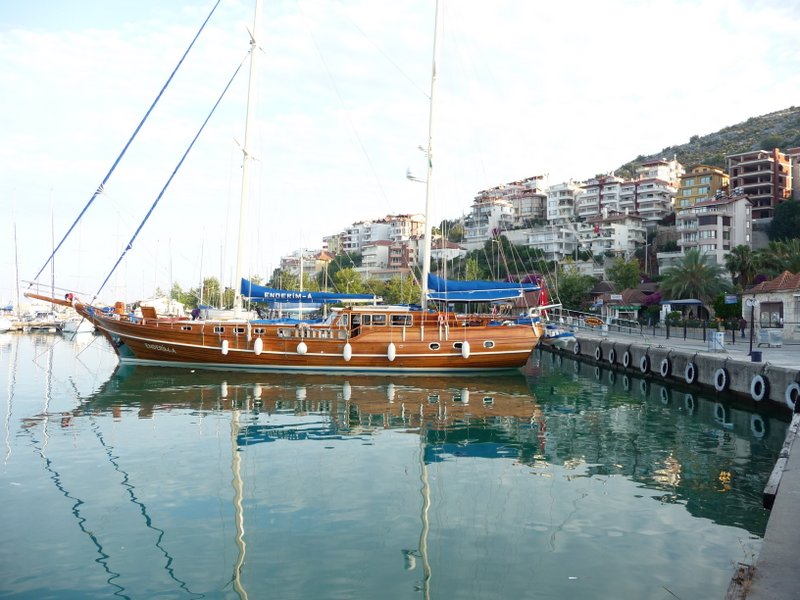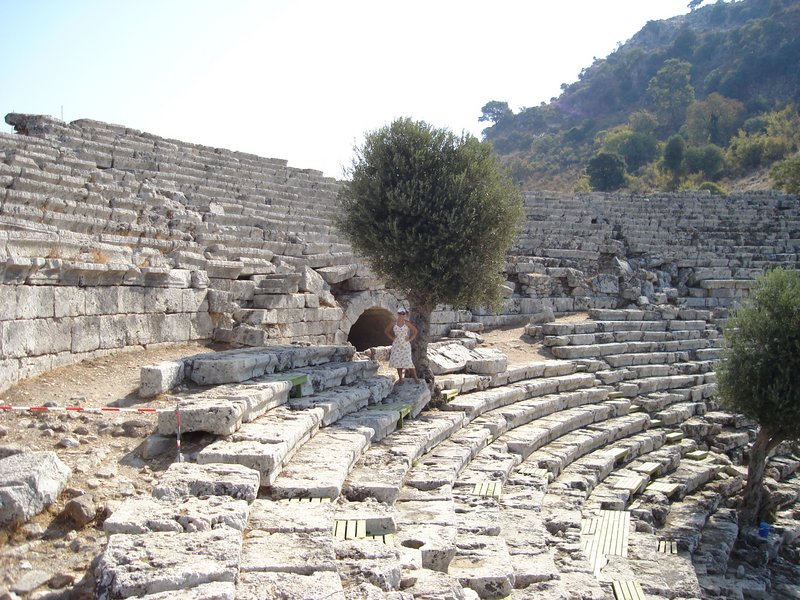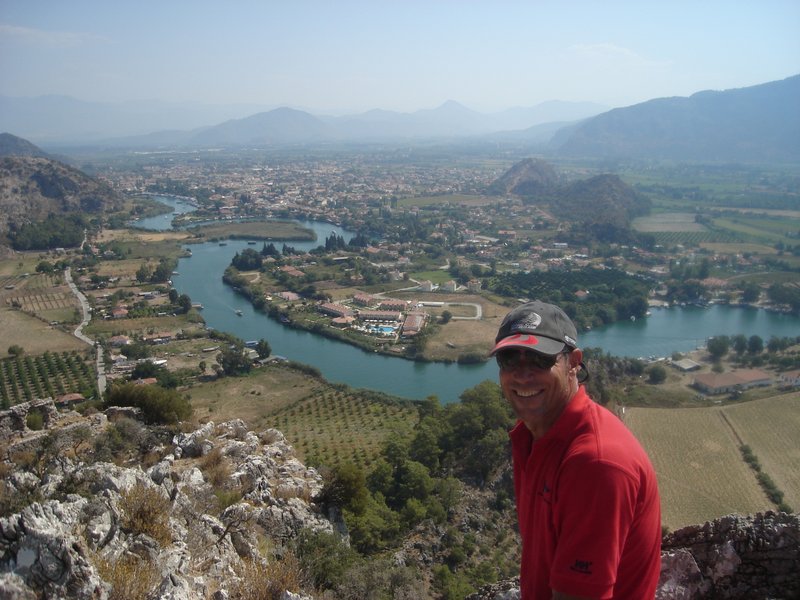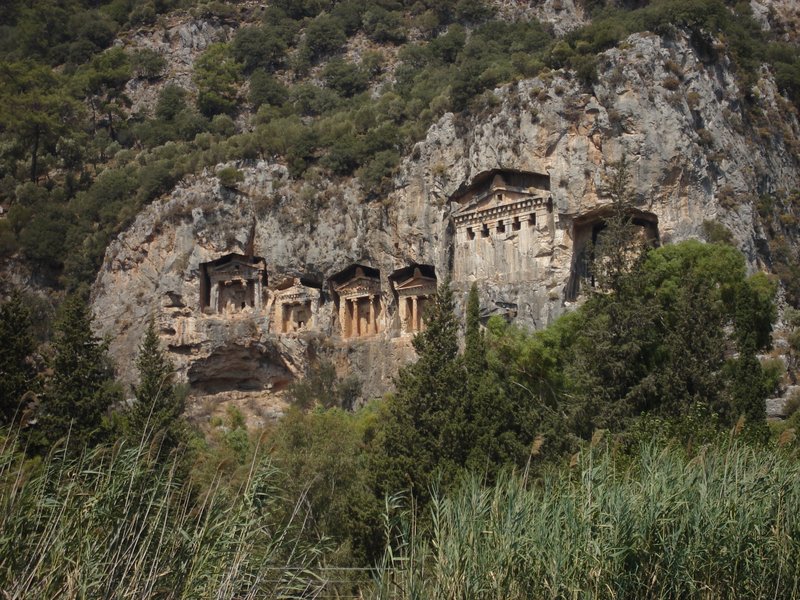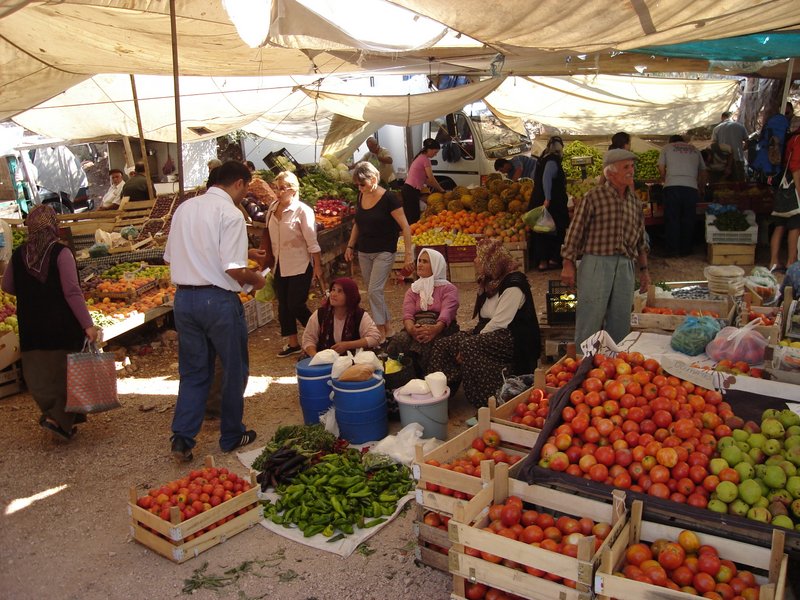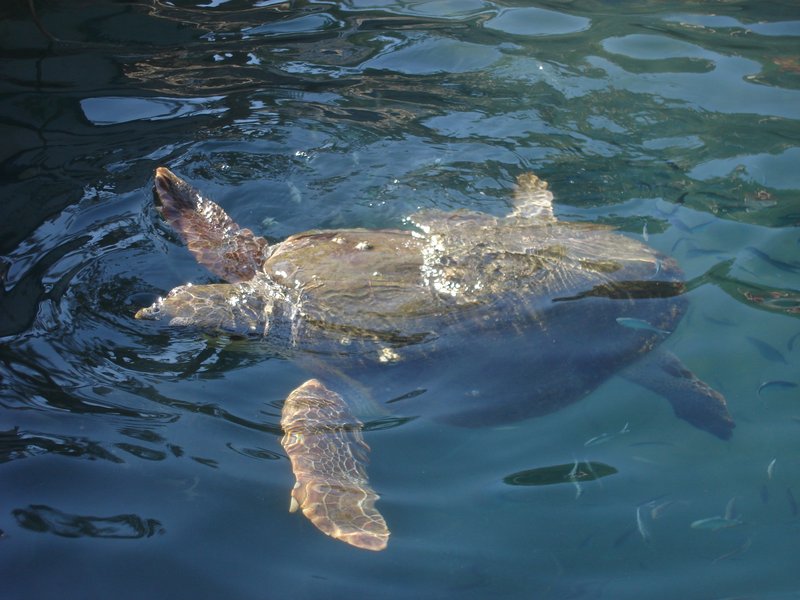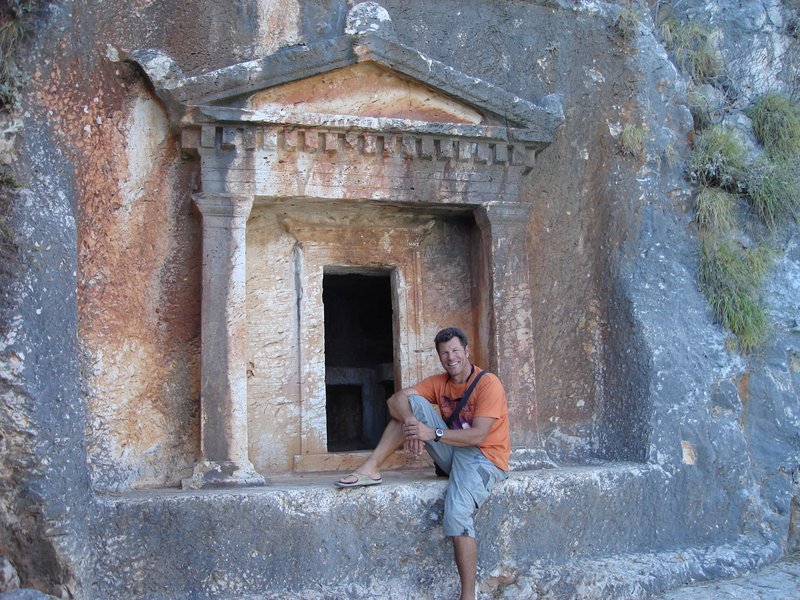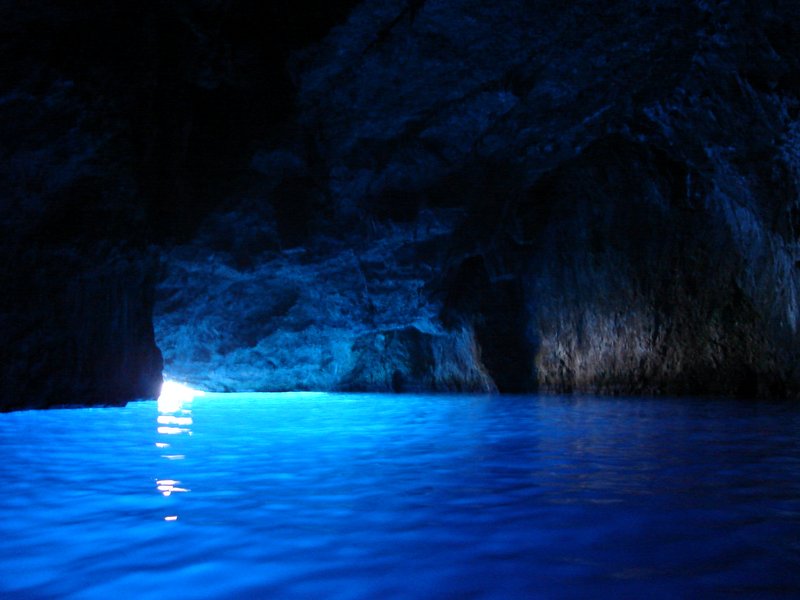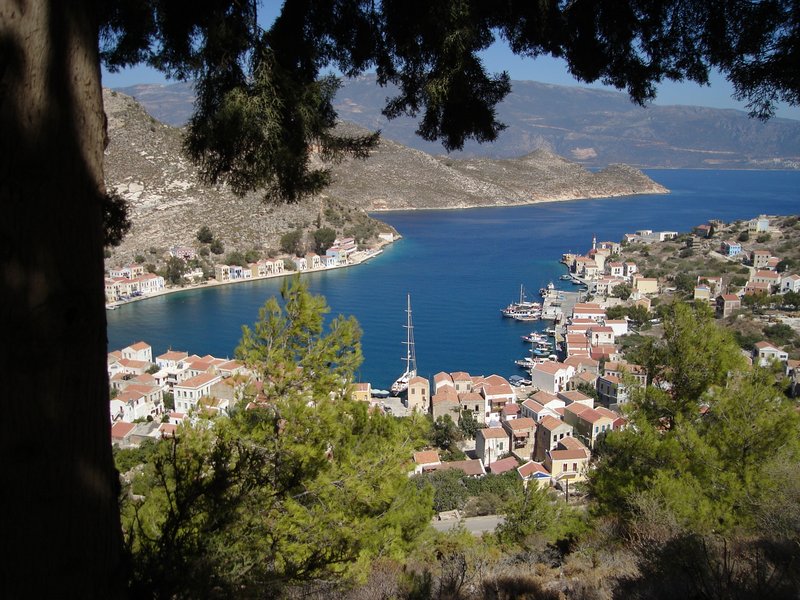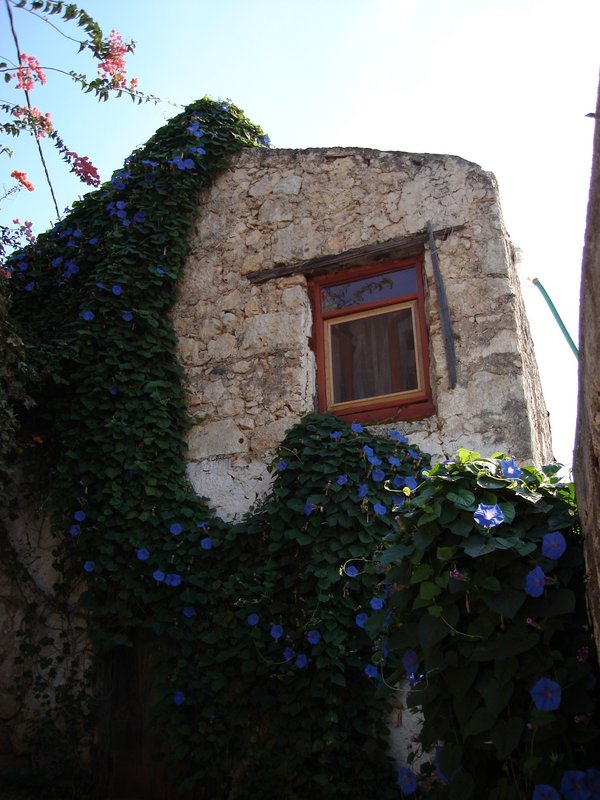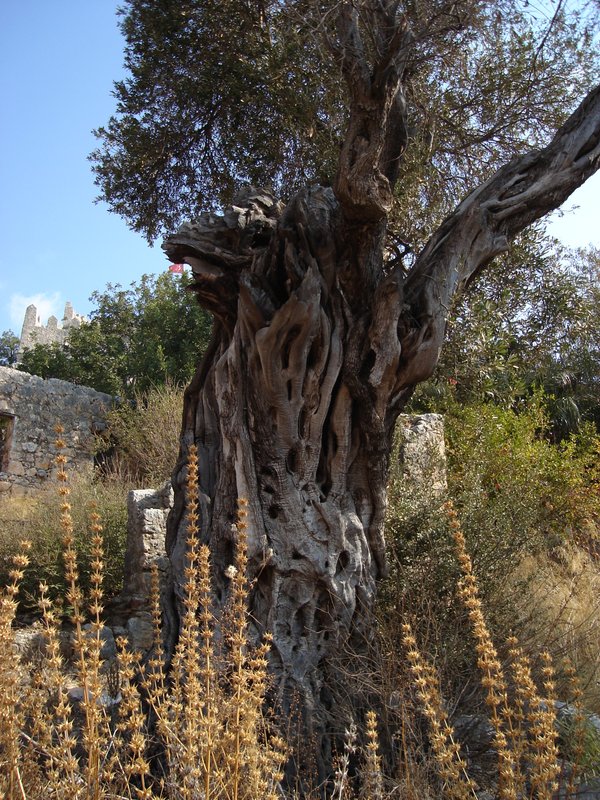The Lycian Coast is situated on the southwest corner of Turkey where the Aegean Sea meets the Mediterranean. A “Blue Voyage” on a Turkish gület along this coastline is listed in 1000 Places to See Before You Die, popular for it turquoise waters, Greco-Roman ruins, sun drenched beaches and great food. We experienced all this on our leisurely two week do-it-yourself meander down the coast.
A Turkish gület
We left the hustle and bustle of Marmaris town behind and found anchorage in a small inlet called Turunç Bükü, just outside of the Bay of Marmaris. While the bay was lined with holiday resorts, we were relieved to have a quiet, if not a bit rolly evening away from the big city lights and all-night revelry.
The following day we made a short hop east and anchored behind Delicada (Dalyan) island just to seaward of the Dalyan River bar. When we arrived, the place was buzzing with day tripper and river boats, and the long brown-sand beach was packed with tourists. A fellow came by and offered us an all day tour of ruins at Kaunos, the town of Dalyan, the fresh water lake and some mud baths for US $200. We declined, figuring we might be able to do it ourselves in the dinghy. Thankfully by sunset the place went into ghost town mode and we were the only boat left.
We took a short dinghy ride over the bar and up into the marshland at the mouth of the river to get a feel of the place before it got dark. The anchorage was not particularly well protected but the weather had been very settled and we did have a relatively comfortable night, only rolling a bit after the sea breeze died and before the land breeze filled in from the opposite direction, keeping us more or less in line with the gentle swell.
We headed out early the next morning dodging the loggerhead turtles hanging out in the shallow waters of the Dalyan River bar. Once over the shallow bar, there was plenty of water and we found navigation through the wide reed-lined tributaries fairly easy as the local boat’s large red Turkish flags were visible for quite a distance, giving us a rough guide as to where we should be heading.
Our first stop was at a fish farm blocking the entire fork of the river. There was a dock to tie up, and from there it was a short walk to the ancient Roman city of Kaunos. In its day, Kaunos had many things going for it; a high hill for the fortification, a well protected harbor, fresh water from the river, pine trees growing on the hills for timber and plenty of flat farm land. The speculation is that Kaunos failed because harbor is now 3 kilometers inland due to silting, and it is reported that many of the people living there had a yellow cast to their skin from the endemic malaria.
The ancient theatre was still in good shape, as were Roman baths, an agora and a few other buildings on the site. When we visited the theater, they were setting up for some sort of musical event to be staged that evening. We decided to get a bit of exercise and hiked up to the ruin of the fort overlooking the city and sea. The path was little more than a slippery rock goat track, and totally unmarked. We finally made our way to the top for a commanding view of the marshland, Mediterranean Sea, and the picturesque village of Dalyan further inland. We also sorted out how to make our way there through the maze of tributaries and through the fish traps.
Merima found a bit of shade in the ancient theatre of Kaunos
Overlooking Dalyan
We made our way back down to sea level and found our way by dinghy up to Dalyan. Just across from the village are ornate Lycian tombs, carved into the face of the cliff. Some of the lower tombs had apparently been removed by pillagers leaving just square holes in the cliffs, but the ones higher up remain intact and were quite impressive. We continued upstream till the river opened up into a huge fresh water lake. I’m sure the dingy outboard appreciated a full-throttle run and a good flushing. We returned to Dalyan and enjoyed a traditional Turkish lunch on the riverfront, while watching turtles dodge the constant parade of tourist boats chugging up and down the river. It was a thoroughly enjoyable day and we were happy to have a chance to see a bit of ancient Turkey.
Lycian tombs
The breeze had come up a bit and we decided not to tempt fate, so after our day’s excursion, we moved north up the coast a few miles to a lovely and more protected anchorage in a bay called Ekinçik Limani. We found good holding in 17 meters away from the charter boats and gülets and it was very calm, quiet and well worth the four mile battery-charge run.
We next headed to the large bay of Fethiye Körfezi about 20 miles southeast. This area is a lovely cruising ground as there are many islands and picturesque, deeply indented coves providing good shelter. It is also close to the charter hub of Göçek, so there were plenty of yachts to fill up all those coves. We found a very pretty, pleasant and uncrowded spot to anchor on the north side of a little island called Domuz Ad, and tied our stern to an olive tree on the rocky shoreline.
We began to notice that when we were cooking that the flame was very smoky and left black soot on our pots and pans, not to mention a foul odor that made us feel a bit queasy. After a bit of thought, we recalled that the gas cylinder we were using was filled in Suakin, Sudan. This was the place where the diesel repeatedly clogged our Baja filter, the gasoline we purchased clogged the dinghy carburetor and had to be discarded, and now the LPG had to go! We changed over to our back-up cylinder and nicknamed the town that had a perfect record for bad combustibles “Sewer-can.”
I went for a snorkel in the warm, clear water and saw remnants of ancient amphora embedded in the bottom. After my last dive I came up to a loud racket. On shore was a donkey screeching his disapproval as if I was encroaching on his space. The next day a French yacht tied up next to us and once again was greeted by a loud protest from this donkey, so I didn’t feel so bad.
After a few relaxing days on the hook, we decided to head into a marina and get some LPG, groceries and do some laundry. We made our way north to the head of the bay and the lovely little town of Göçek. We popped into the Port Göçek Marina which is owned by Swissotel and run by Camper and Nicholsons. It is a first class marina with excellent facilities, many nice amenities and beautifully landscaped grounds. Göçek is a friendly little village situated at the head of a bay, surrounded by pine forest and with dramatic mountain peaks looming in the distance. An impressive array of supermarkets, cafes, restaurants and chandleries are all within walking distance to the marina. It is the kind of place where one might want to base their yacht or winter over.
It is also the kind of Turkish village where weddings are a public affair. We were there on a weekend, so on both Friday and Saturday nights we were treated to some wonderful live Turkish music as part of the wedding celebrations. We walked into town on Saturday evening, and the whole village seemed to have come down to party and dance with the bride and groom at a little amphitheatre-like area on the waterfront. On Sunday there was a great local market on the edge of town, about a 20 minute walk from the marina. In a large area, covered in makeshift tents, there was a huge array of house wares, hardware, clothes, toys, fresh produce, herbs and spices, breads, local cheeses and olives. Perfect for provisioning!
The market at Göçek
With a good breeze, we sailed south down the coast about twelve miles to the town of Fethiye, which was once the ancient town of Telmessus. Fethiye is situated on one side of a large but well protected bay, surrounded by high, pine-covered hills. While most of the town’s buildings are of recent architecture, there are still ruins of Crusader castle on the hill above, and a few Lycian tombs carved into the faces of the cliffs just below.
On our first visit to town, we were greeted by a large sea turtle playing near the quay where the fishing boats were tied. After a stroll around the town center, we were impressed by the friendliness of the people, the laid back vibe, and low volume of tourism. Fethiye is the kind of place where a week can pass you by before you know it-it did for us. That night we returned to town for a meal out to celebrate Merima’s birthday and ended up on the bar street sipping drinks, listening to some great music and chatting away with some friendly Turks at a convivial little joint called the Car Cemetery Bar.
A turtle playing near the quay in Fethiye
There is quite a nice shopping bazaar in the middle of town, and on Tuesdays, there is a huge local market. In this part of the world, market day is an event, and it is apparent that people come for miles around to buy, sell and socialize in the casual atmosphere of the market. We found it a great place to stroll, people watch, check out the interesting items on offer, and pick up a few fresh fruits and veggies.
One morning our daily walk took us to the head of the bay, where there was a large boat yard building traditional wooden power boats and gülets. The manager of the yard was most welcoming. He chatted with us a bit and invited us to have a look around. When we visited, there were no less than nine vessels under construction and a hundred craftsmen on site. All the boats were being fabricated of exotic African hardwoods in the traditional fashion, with wood planking fastened to laminated ribs. With the exception of some small power tools, not much of the building process appears to have changed since the days of Noah. It was fascinating to see these boats in their various stages of completion, with craftsmen meticulously hand forming and fitting each piece. While the yard itself was about as basic as it gets, the end result, a just launched gület, was something to behold.
After another night on the town in Fethiye, we decided to get back out and find a quiet little anchorage down the coast. Departing Fethiye, the coast to the south is spectacular with very rugged coastline and mountains soaring 2000 meters above sea level. We tried to find a spot at Ölü Deniz, a magnificent land-locked lagoon about 15 miles from Fethiye. The small anchorage was full, but we hovered around awhile checking out the beautiful beach and the dozens of para gliders dropping down from Mt. Baba which towered above the lagoon. We found a good calm spot to anchor behind a nearby island called Gemiler Adasi, which was covered in ancient ruins.
Gemiler anchorage was fine until late in the afternoon when it became a sort of Grand Central Station for gülets. They were coming and going all through the night, making lots of noise and dropping their anchor rodes over ours. A bit of swell started to work its way around the island late in the evening, so we decided we’d make an exit the next morning as soon as our rode was clear of the gület’s.
We headed south down a beautifully rugged stretch of coast line about 30 miles toward the little town of Kalkan. From seaward we could see deep gorges slashing the mountain sides, cliffs pockmarked with caverns, sea caves and many areas of relatively recent rock fall.
Once a quiet little Greek fishing village, Kalkan has now been taken over by tourism. It still has a lovely charm about it, with plenty of nicely restored old Greek and Ottoman buildings, narrow lanes, and splashes of bougainvillea everywhere. The harbor is small but well protected, and right next to the town which is notable for its very upscale shops, restaurants and cafes catering to the tourists and visiting yachties. We were lucky to get in by mid-day because every night the harbor was absolutely chocker-block. While we had a nice outlook facing the village, we were literally squashed between a massive gület and a large charter yacht, with fenders compressed. We enjoyed some day and evening strolls around town, a meal out and a few drinks at one of the rock-and-roll bars, but after two nights we were ready to move on.
Our next stop was the island of Kastellórizon. Kastellórizon is actually the last of the Dodacanese islands and the furthest Greek Isle away from Athens. Its nearest bit of homeland is Ródhos, 70 nautical miles away, but lies just a mile off the coast of Turkey. Kastellórizon has had a tumultuous past but from all appearances is once again on the rise, thanks to tourism. For this reason, the local officials ignore a visit by yachts cruising along the coast of Turkey, and allow them to anchor or tie up for a day or two and drop a few Euros into the local economy.
With its beautiful natural harbor lined in beautiful old Greek mansions and surround by dry rock landscape, Kastellórizon reminded us a bit of Sými or Khálki further north in the Dodacanese. The biggest difference is that there are so few tourists that they can go almost unnoticed. To say that it is quaint is an understatement. If one arrives by yacht and med-moors to the low quay, one can literally step off their pasarelle and be seated at a table at one of the half dozen or so little restaurants lining the rather narrow waterfront quay.
Kastellórizon
Craving a bit of and privacy after being in a harbor, feeling like we were the black key stuffed among the white keys on a piano, we decided to anchor just around the corner from the entrance to the town harbor at a nice little anchorage called Mandraki. We took the dinghy ashore and found an old stone pathway that led around the edge of the castle-crowned hill to the village. Along the pathway there was a rather precarious handrail-less stairway, leading up to what it purported to be the only Lycian tomb in Greece, carved into the solid rock cliff face. The tomb is of course empty, but it was interesting to view one of these up close to see the detail, not to mention the perfection of the carving of lines, angles and flat faces.
The only Lycian tomb in Greece
In the town of Kastellórizon many of the grand old buildings lay in ruin as a result of war, earthquake and abandonment, while quite a few have been lovingly restored as homes and hotels, and a surprising number are work in progress. We ran in to some cruising friends from the Indian Ocean/Red Sea trip and enjoyed a lovely Greek seafood meal at a small taverna on the quay that evening.
The next morning with the sun still low, we took the dink around to the southeast corner of the island and managed to find the grotto of Perastá. We weren’t exactly sure of its location, but I was able to identify the opening from a photo in a tourist brochure. The entrance to the grotto is only about three meters wide and barely high enough for the dinghy outboard to clear the opening above. Driving in for the first time, we felt like we were entering the mouth a whale ready to swallow us up. Once inside the room opens up to an immense size, and the light reflecting through the water at the opening casts lovely hues of blue dancing lights on the cavern walls. As our eyes became accustomed to the lower level of light, we could make out the forms of the stalactites above. Occasionally when a large swell would come into the grotto, compressing the warm and humid air, the atmosphere would fog up for an instant. The grotto of Perastá is quite impressive and frankly, puts the Blue Grotto of Capri to shame.
Inside the Grotto of Perastá
After spending some time underground, we decided to get a bit of exercise and hike up to the monastery of Ayíou Yeoryíou (St. George) toú Vounioú, situated on a high plateau in the middle of the island and dating back to the 16th century. The walk started behind the town, working up a long winding stone path/stairway. Once above the cliffs, the path straightened out and narrowed into a rough, rocky track bordering some goat pastures. George may have slain the dragon, but left the snakes, as we saw a few small ones slithering into the cracks in the rocks as we approached.
From the main entrance, the monastery appeared to be fenced in and locked up. Walking around to the back, there is a large hole in the wall through which we could walk into the main courtyard and check out some of the open rooms and crumbling structures. In typical Greek fashion, while all was crumbling around it, the Orthodox chapel was intact. In fact it had been well maintained, and the door was locked, protecting all the religious artifacts inside.
It was a clear and calm morning and the walk back to sea level rewarded us with many outstanding panoramic views of the harbor and village, the Turkish mainland and surrounding islets.
View of Kastellórizon from the monastery of Ayíou Yeoryíou toú Vounioú
The next morning we made the short trip across to mainland Turkey and the town of Kaş. The meltemi had been at rest for a few days, and Kaş Limani (bay) was exceptionally calm. Instead of going into another “sardine can” harbor, we anchored Moonshadow in the bay just outside the harbor and took a long stern line around a rock on the breakwater, keeping our bow pointed into the gentle swell through the shifty breezes.
Kaş is a lovely little holiday town with a central area jammed with shops, galleries, cafes bars and restaurants. A large and very intact ancient amphitheater overlooks the bay and in the high cliffs behind the town are a number of Lycian tombs which are illuminated at night. The actual top of the mountain is shaped like a sort of eerie space-man looking creature lying on his right side. On Fridays there is an excellent fresh produce market on the edge of town under awnings stretched between the trees of an old olive orchard. We came back with big bags of excellent fruits and veggies that cost just one to two Turkish Lira (US $ .70-$1.40) each.
A week or so previously was the start of the Muslim holy month of Ramadan. During Ramadan, Muslims, if they are able, are meant to abstain from food and drink during daylight hours as a show of understanding for those less fortunate. In some places they actually fire gun shots or fireworks to wake people up early enough to eat breakfast before the Morning Prayer at sunrise, and again after sunset to let people know that they can tuck into the evening feast. While we’ve enjoyed listening to the call to prayer, especially if the Imam has a good singing voice, the gunshot thing took us a bit of getting used to.
Heading further down the coast we stopped in a lovely little area called Kekova. Kekova is actually a long island lying just off the coast, protecting a long stretch of coastline and number of lovely little bays. We anchored in Üçağiz Limani (Bay) near a small fishing village with the same name. The mainland and islands around Kekova area are dotted with ancient ruins and sarcophagi.
After we anchored, we headed ashore for a stroll around the village of Üçagiz. While it is billed as an unspoiled fishing village, most of the restaurants that dominate the waterfront have sprouted long, rickety and rather tacky looking jetties that are meant to attract yachts and gülets to their dining tables with water, power and sometimes even Internet. We found it rather off-putting, and couldn’t understand why someone would want to tie up and be beholden to a restaurant when there was a huge free anchorage with shallow depths, good holding room between you and your neighbor. The village itself was rather average looking, but is situated on the site of the ancient city of Teimiussa. We enjoyed wandering around and climbing on some of the interesting ruins on the east end of the town over looking the bay.
The next morning before the tourist boats had arrived, we took the dink across the bay to the hamlet of Kaleköy. Kaleköy sits on the ancient city of Simena, part of which is a few meters underwater thanks to a major earthquake a couple millennia ago. One can still see building foundations and a sarcophagus just above and below the crystal clear water.
Kaleköy cascades from a small but attractive Crusader castle down a steep hillside to the sea. While it also has restaurants with jetties, they seem to have done a better job of the aesthetics than their neighbors across the bay. We had a nice walk through the rocky paths of the village up to the castle which of course has commanding views of the bays, islands and surrounding countryside. One of the interesting features of the castle was its small amphitheater, with seating for perhaps 100, carved entirely out of the face of the stone hillside. I’m not sure if it was because it was early in the day or late in the season, but we had the entire place to ourselves.
View from the castle at Kaleköy
Most of the homes in Kaleköy appear to be very old and are built of stone with terracotta tile roofs. Colorful flowers, basil and oregano are growing on or around many of the homes adding to the charm of the hamlet. Dotting the rocky hillside are thousand year old olive trees, with wildly contorted trunks, that are still yielding fruit. The locals were very friendly and one young Turkish girl selling pareos attached herself to us, giving us a bit of a tour and telling us a bit of the local history in her excellent English.
An old stone home in Kaleköy
A thousand year old olive tree
As we approach Finike, one of the popular wintering over ports for yachties, we’ve run into more and more cruising friends and enjoyed sundowners on one of the small rock islets in the bay with friends from Cap d’Or, Fidela and Raconteur.
The next morning we lifted the anchor for the last time of the season. It was as slow process as it came up from a muddy bottom and had to be washed down. We motored and motor-sailed in light breezes and flat waters the last 18 miles to Finike, a small town that is hardly given a mention in the tourist guides. As we approached the Setur Finike Marina, Merima and I got a bit teary thinking that this was the last cruising we’d be doing for awhile. We were a bit sad thinking about leaving Moonshadow, especially after the incredible year that we’ve just spent in our transit from Southeast Asia to the Med, and some of the wonderful and amazing places we’ve visited since January along our 7200 mile track. On the other hand, we felt the first few drops of rain since last April in Oman, and we’ve had to pull out the duvet as the nights become cooler. It’s time for these birds to fly south for the winter!
Moonshadow will be in dry storage in Finike till we return to her next May. We’ll be flying home to Auckland in a few days. Merima has been welcomed to come back to work for the summer by her previous employer and is excited to see her old work mates and dust off her pre-cruising skill sets. I’ve been invited to work on a book project which should keep me out of trouble for a few months. We’re both looking forward to summer in New Zealand and life for awhile as “earthlings.”

